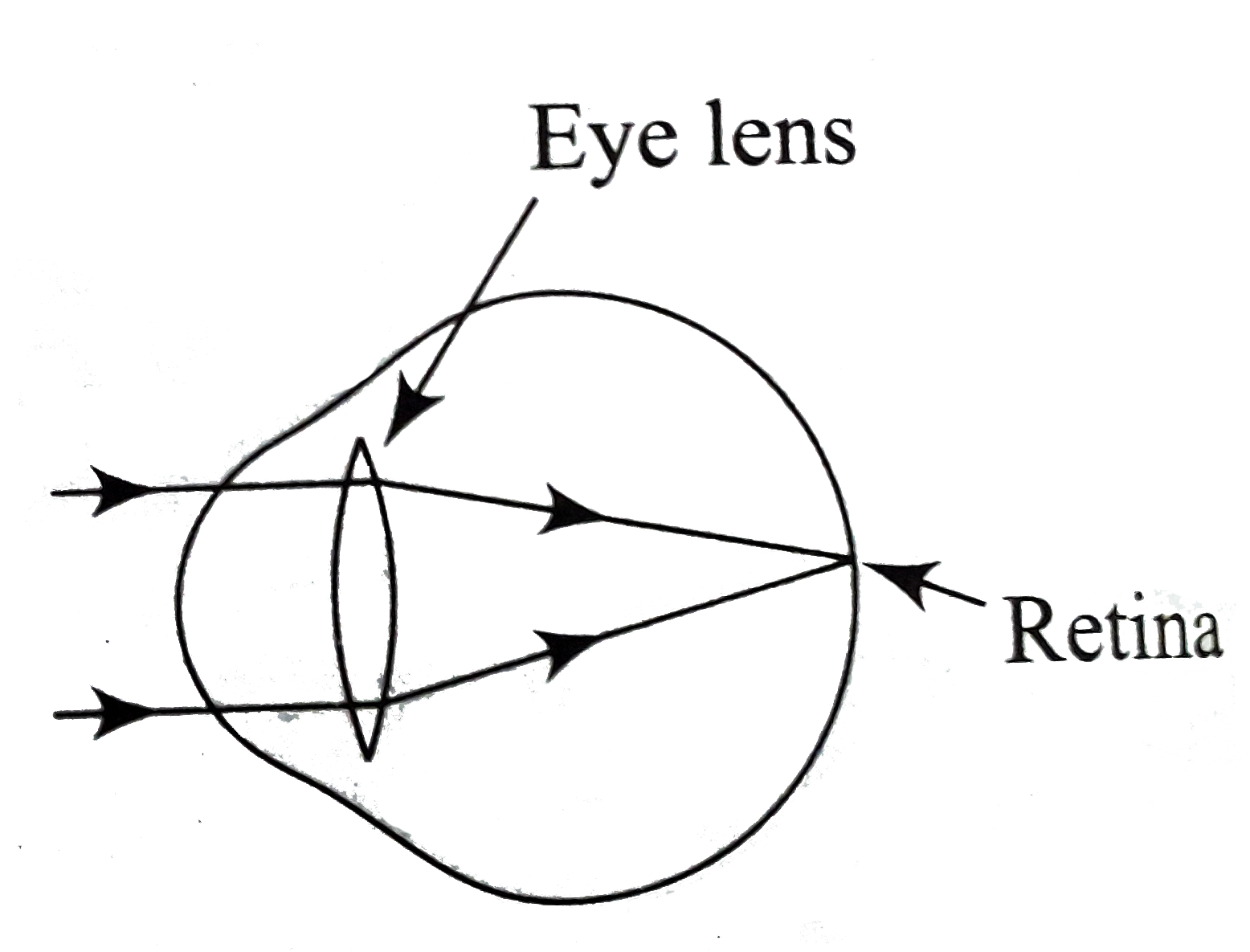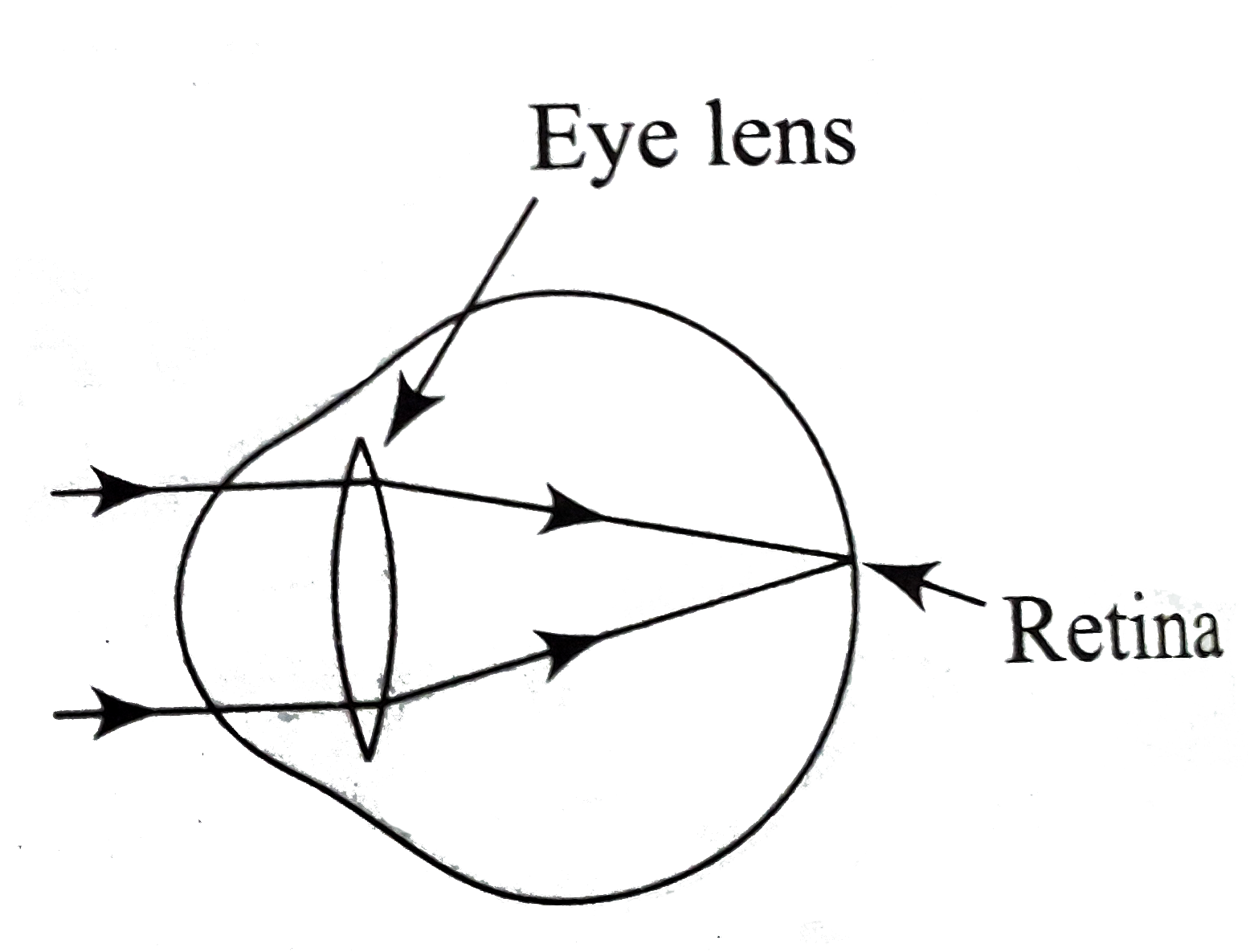The optical prescription for a pair of spectacles is:
Right eye: −3.50D Left eye: −4.00 D
a) Are these lenses thinner at the middle or at the edges?
b) Which lens has a greater focal length?
c) What is the weaker eye?
a) Thinner at the middle b) Lens of lower power: =−3.50D c) Left eye
Topper's Solved these Questions
- REFRACTION OF LIGHTBOOK - LAKHMIR SINGH & MANJIT KAURCHAPTER - REFRACTION OF LIGHTEXERCISE - LONG ANSWER TYPE QUESTIONS
3 Videos
- REFRACTION OF LIGHTBOOK - LAKHMIR SINGH & MANJIT KAURCHAPTER - REFRACTION OF LIGHTEXERCISE - SHORT ANSWER TYPE QUESTIONS
1 Videos
- REFRACTION OF LIGHTBOOK - LAKHMIR SINGH & MANJIT KAURCHAPTER - REFRACTION OF LIGHTEXERCISE - VERY SHORT ANSWER TYPE QUESTIONS
1 Videos
- REFLECTION OF LIGHT BOOK - LAKHMIR SINGH & MANJIT KAURCHAPTER - REFLECTION OF LIGHT EXERCISE - Very Short Answer Type Questions
1 Videos
- SOURCES OF ENERGY BOOK - LAKHMIR SINGH & MANJIT KAURCHAPTER - SOURCES OF ENERGY EXERCISE - NCERT
8 Videos
Similar Questions
A person got his eyes tested by an option. The prescription for the spectacle lenses to be made reads:
Left eye: +2.50D Right eye: +2.00 D
a) State whether these lenses are thicker in the middle or at the edges.
b) Which lens bends the light rays more strongly?
c) State whether these spectacle lenses will converge light rays or diverge light rays.
View SolutionA person having a myopic eye uses a concave lens of focal length 50 cm. What is the power of the lens?
View Solution
Knowledge Check
The optical prescription for a pair of spectacles is, Right eye : + 2.50 D and Left eye : + 4.00 D. Which of the following statement is true for above condition?
AThe lens of left eye has greater focal length.BThe given values are power of concave lensesCThe lens of right eye has greater focal length.DThe person is suffering from nearsightedness.A person got his eyes tested. The optician's prescription for the spectacles reads Left eye = 3.00 D, Right eye = 3.5 D The person is having a defect of vision called
AmyopiaBhypermetropiaCpresbyopiaDastigmatismTwo lenses of power+2.50Dand−3.75Dare combined to form a compound lens Its focal length in cm,will be
A40B-40C-80D160
The optician's prescription for a spectacle lens is marked +0.5D. What is the,
a) nature of spectacle lens?
b) Focal length of spectacle lens?
View SolutionShashank went to the optician to get his eyes checked. He observed that the doctor combined two lenses and put these in front of his eyes so that he could see clearly. The powers of the two lenses used in the combination were -3 D and 4 D.
Which of these will be the focal length of the combination of lenses Shashank has to wear?
View SolutionThe ciliary muscles of eye control the curvature of the lens in the eye and hence can alter the effective focal length of the system. When the muscles are fully relaxed, the focal length is maximum. When the muscles are strained, the curvature of lens increases. That means radius of curvature decreases and focal length decreases. For a clear vision, the image must be on the retina. The image distance is therefore fixed for clear vision and it equals the distance of retina from eye lens. It is about 2.5cm for a grown up person.
A perosn can theoretically have clear vision of an object situated at any large distance from the eye. The smallest distance at which a person can clearly see is related to minimum possible focal length. The ciliary muscles are most strained in this position. For an average grown up person, minimum distance of the object should be around 25cm.
A person suffering from eye defects uses spectacles (eye glass). The function of lens of spectacles is to form the image of the objects within the range in which the person can see clearly. The image o the spectacle lens becomes object for the eye lens and whose image is formed on the retina.
The number of spectacle lens used for th eremedy of eye defect is decided by the power fo the lens required and the number of spectacle lens is equal to the numerical value of the power of lens with sign. For example, if power of the lens required is +3D (converging lens of focal length 100/3cm ), then number of lens will be +3.
For all the calculations required, you can use the lens formula and lensmaker's formula. Assume that the eye lens is equiconvex lens. Neglect the distance between the eye lens and the spectacle lens.

Q. A far sighted man connot see objects clearly unless they are at least 100cm from his eyes. The number of the spectacle lenses that will make his range of clear vision equal to an average grown up person will be
View SolutionThe ciliary muscles of eye control the curvature of the lens in the eye and hence can alter the effective focal length of the system. When the muscles are fully relaxed, the focal length is maximum. When the muscles are strained, the curvature of lens increases. That means radius of curvature decreases and focal length decreases. For a clear vision, the image must be on the retina. The image distance is therefore fixed for clear vision and it equals the distance of retina from eye lens. It is about 2.5cm for a grown up person.
A perosn can theoretically have clear vision of an object situated at any large distance from the eye. The smallest distance at which a person can clearly see is related to minimum possible focal length. The ciliary muscles are most strained in this position. For an average grown up person, minimum distance of the object should be around 25cm.
A person suffering from eye defects uses spectacles (eye glass). The function of lens of spectacles is to form the image of the objects within the range in which the person can see clearly. The image o the spectacle lens becomes object for the eye lens and whose image is formed on the retina.
The number of spectacle lens used for th eremedy of eye defect is decided by the power fo the lens required and the number of spectacle lens is equal to the numerical value of the power of lens with sign. For example, if power of the lens required is +3D (converging lens of focal length 100/3cm ), then number of lens will be +3.
For all the calculations required, you can use the lens formula and lensmaker's formula. Assume that the eye lens is equiconvex lens. Neglect the distance between the eye lens and the spectacle lens.

Q. Maximum focal length of a eye lens of a normal person is
View SolutionThe ciliary muscles of eye control the curvature of the lens in the eye and hence can alter the effective focal length of the system. When the muscles are fully relaxed, the focal length is maximum. When the muscles are strained, the curvature of lens increases. That means radius of curvature decreases and focal length decreases. For a clear vision, the image must be on the retina. The image distance is therefore fixed for clear vision and it equals the distance of retina from eye lens. It is about 2.5cm for a grown up person.
A perosn can theoretically have clear vision of an object situated at any large distance from the eye. The smallest distance at which a person can clearly see is related to minimum possible focal length. The ciliary muscles are most strained in this position. For an average grown up person, minimum distance of the object should be around 25cm.
A person suffering from eye defects uses spectacles (eye glass). The function of lens of spectacles is to form the image of the objects within the range in which the person can see clearly. The image o the spectacle lens becomes object for the eye lens and whose image is formed on the retina.
The number of spectacle lens used for th eremedy of eye defect is decided by the power fo the lens required and the number of spectacle lens is equal to the numerical value of the power of lens with sign. For example, if power of the lens required is +3D (converging lens of focal length 100/3cm ), then number of lens will be +3.
For all the calculations required, you can use the lens formula and lensmaker's formula. Assume that the eye lens is equiconvex lens. Neglect the distance between the eye lens and the spectacle lens.

Q. Minimum focal length of eye lens of a normal peson is
View Solution
